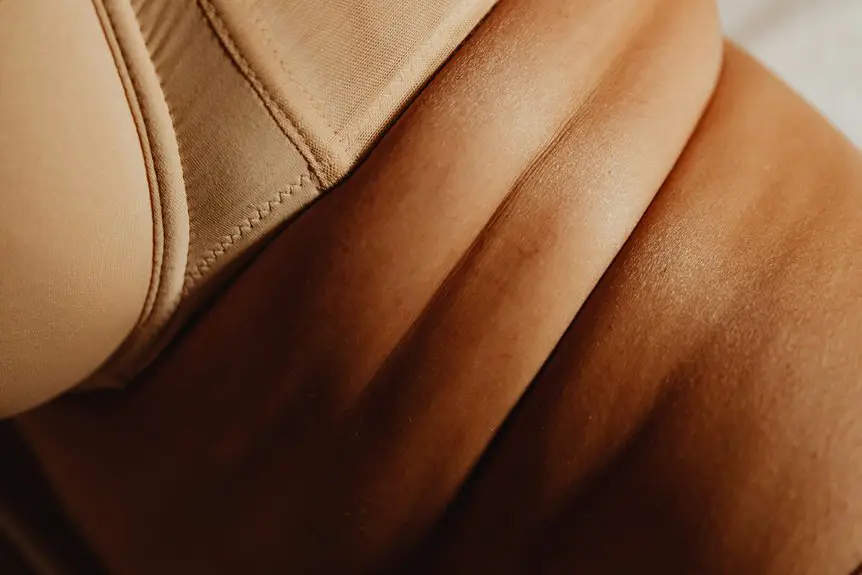Lyocell is great for sensitive skin because it’s hypoallergenic, breathable, and moisture-wicking, helping keep your skin dry and irritation-free. Its smooth, soft fibers reduce friction and prevent redness or itching, making it gentler than cotton or synthetic fabrics. Plus, lyocell resists dust mites and bacteria, which lowers allergy risks. You’ll also find it dries quickly and feels cool, which supports overall skin health. Keep exploring to discover how lyocell compares and how to care for it properly.
Table of Contents
Key Takeaways
- Lyocell is hypoallergenic, significantly reducing the risk of skin irritation and allergic reactions for sensitive skin.
- Its moisture-wicking properties keep skin dry, preventing irritation caused by sweat and dampness.
- The fabric’s smooth texture minimizes friction, reducing redness and itching on sensitive skin.
- Lyocell is breathable, promoting airflow and preventing overheating that can aggravate skin conditions.
- Natural resistance to dust mites and bacteria lowers allergen exposure, beneficial for sensitive or allergy-prone skin.
Understanding Lyocell: What Is It Made Of?
Lyocell is a type of fabric made from wood pulp, usually sourced from eucalyptus, beech, or spruce trees.
When you wear lyocell, you’re actually wearing a fiber created through a process that dissolves the wood pulp into a solution, then spins it into fiber. This method is more environmentally friendly compared to traditional fabric production because it recycles water and uses fewer chemicals.
The fibers themselves are smooth and strong, giving the fabric a soft, silky feel you’ll appreciate. Since it’s derived from natural sources, lyocell blends nature’s benefits with advanced manufacturing.
Smooth, strong fibers create a silky fabric that perfectly marries nature’s touch with modern innovation.
When you choose lyocell clothing, you’re opting for a fabric that’s biodegradable and sustainable, making it a smart choice both for your skin and the planet.
Key Properties of Lyocell That Affect Sensitive Skin
Because your skin reacts to the fabrics you wear, understanding the qualities that make lyocell suitable for sensitive skin is essential.
Lyocell’s unique properties minimize irritation and promote comfort. Here are four key attributes to evaluate:
- Hypoallergenic nature: Lyocell fibers resist allergens, reducing the chance of skin reactions.
- Moisture-wicking ability: It pulls moisture away from your skin, keeping you dry and preventing irritation.
- Smooth texture: The fiber’s soft, smooth surface feels gentle against your skin, avoiding friction.
- Breathability: Lyocell allows air to flow freely, preventing overheating and sweat buildup.
These properties make lyocell an excellent choice if you have sensitive skin and want comfortable, irritation-free clothing.
How Lyocell Compares to Other Fabrics for Sensitive Skin
When choosing fabrics for sensitive skin, you want to focus on breathability and moisture management.
Lyocell stands out by naturally wicking moisture and allowing air to flow, reducing irritation.
It also compares favorably to other materials thanks to its hypoallergenic properties that minimize allergic reactions.
Breathability and Moisture Management
Although many fabrics claim to offer comfort for sensitive skin, not all handle breathability and moisture management equally.
Lyocell stands out because it actively keeps your skin cool and dry, reducing irritation risk. Here’s how it compares:
- Lyocell fibers absorb moisture more efficiently than cotton, pulling sweat away from your skin.
- Its breathable structure allows better air circulation, preventing heat buildup.
- Unlike synthetic fabrics, Lyocell doesn’t trap moisture, which can cause discomfort or rashes.
- It dries faster than other natural fibers, minimizing prolonged dampness on sensitive skin.
Choosing Lyocell means you’re opting for a fabric that supports your skin’s natural balance, making it an excellent choice if you’re prone to irritation or overheating.
Hypoallergenic Properties Compared
Three key factors make Lyocell a top choice for those with sensitive skin seeking hypoallergenic fabrics.
First, Lyocell’s smooth fibers minimize irritation compared to rougher fabrics like wool or certain synthetics.
Second, its natural resistance to dust mites and bacteria reduces common allergens that often trigger skin reactions.
Third, Lyocell is produced with fewer chemicals than conventional cotton, limiting exposure to irritants.
Unlike synthetic fabrics that can trap sweat and bacteria, Lyocell’s breathability keeps your skin dry and comfortable.
While cotton is also hypoallergenic, it doesn’t manage moisture as effectively, which can aggravate sensitive skin.
Potential Benefits of Wearing Lyocell for Sensitive Skin
You’ll appreciate how lyocell’s hypoallergenic nature reduces irritation on sensitive skin.
It also wicks moisture away, keeping you dry and comfortable throughout the day.
Plus, its breathability helps prevent overheating, making it an ideal fabric choice for your skin’s health.
Hypoallergenic Fabric Qualities
When your skin reacts easily to certain fabrics, choosing hypoallergenic materials like lyocell can make a big difference.
Lyocell’s hypoallergenic qualities help reduce irritation and promote comfort. Here’s why lyocell stands out for sensitive skin:
- It’s naturally smooth, minimizing friction that can cause redness or itching.
- The fabric resists dust mites and allergens better than many traditional fibers.
- Lyocell’s production avoids harsh chemicals, so it’s less likely to carry allergens.
- Its breathable nature prevents the buildup of bacteria that can trigger skin reactions.
Moisture-Wicking Capabilities
Although sensitive skin requires gentle care, choosing fabrics with strong moisture-wicking capabilities can greatly improve your comfort.
Lyocell excels at drawing moisture away from your skin, keeping you dry and reducing irritation caused by sweat buildup. When you wear lyocell, it efficiently pulls moisture from your body to the fabric’s surface, where it quickly evaporates.
This moisture management helps prevent the dampness that often leads to itching, redness, or rashes, common issues for sensitive skin. By keeping your skin dry, lyocell minimizes the risk of bacterial growth and inflammation.
Breathability and Comfort
Because lyocell fibers allow air to circulate freely, they help regulate your body temperature and prevent overheating. This breathability is essential if you have sensitive skin, as it minimizes sweat buildup and irritation.
When you wear lyocell, you’ll notice:
- Enhanced airflow keeps skin cool and dry throughout the day.
- Soft, smooth texture reduces friction and prevents chafing.
- Natural moisture management helps maintain skin’s balance.
- Lightweight fabric feels comfortable even during extended wear.
These benefits combine to create a fabric that’s not only gentle but also supportive of your skin’s health.
Choosing lyocell means you can stay comfortable and confident without worrying about irritation or discomfort, making it an excellent option for your sensitive skin wardrobe.
Possible Skin Reactions and How to Avoid Them
If you have sensitive skin, you might notice occasional irritation even with gentle fabrics like lyocell.
Sometimes, this happens because of residual chemicals from the manufacturing process or detergents used during washing. You could also react to dyes or fabric finishes applied to lyocell garments.
To avoid these skin reactions, always choose lyocell clothing labeled as hypoallergenic or free from harsh chemicals. Wash new items before wearing them to remove any residues. Opt for mild, fragrance-free detergents, and avoid fabric softeners that may cause irritation.
If you experience redness, itching, or rash, discontinue use and consult a dermatologist. Paying attention to these factors can help you enjoy lyocell’s benefits without discomfort.
Tips for Caring for Lyocell Garments to Maintain Skin Friendliness
Caring for your lyocell garments properly helps keep them gentle on your skin and extends their lifespan. To maintain their skin-friendly qualities, follow these tips:
- Wash lyocell in cold water using a mild detergent to prevent fabric damage and skin irritation.
- Avoid using bleach or fabric softeners, as they can break down fibers and cause sensitivity.
- Air dry your lyocell clothes instead of using a dryer to preserve softness and prevent shrinkage.
- Store garments in a cool, dry place to avoid mold or mildew, which can irritate sensitive skin.
Frequently Asked Questions
Can Lyocell Fabrics Help With Eczema Flare-Ups?
You might worry lyocell won’t soothe eczema, but it actually can. Its smooth, breathable fibers reduce irritation and wick moisture away, helping you stay comfortable during flare-ups without aggravating your sensitive skin.
Is Lyocell Safe for Babies With Sensitive Skin?
You can trust lyocell for babies with sensitive skin because it’s soft, breathable, and hypoallergenic. It helps reduce irritation and keeps their skin comfortable, making it a safe fabric choice for your little one.
How Does Lyocell Perform in Hot and Humid Climates?
Lyocell wicks moisture like a desert oasis, keeping you cool and dry in hot, humid climates. You’ll love its breathability and softness, which prevent clinginess and irritation, making it perfect for sweaty, sticky days.
Are There Any Environmental Concerns Linked to Lyocell Production?
You should know lyocell’s production is eco-friendlier than many fabrics since it uses a closed-loop process recycling solvents. However, it still relies on wood pulp, so sustainable sourcing and water use remain important environmental concerns.
Does Lyocell Cause Allergies When Mixed With Other Fibers?
Imagine a fabric dance where fibers intertwine; when lyocell blends with others, it rarely sparks allergies. You’ll mostly find it gentle, but your skin’s unique rhythm might react, so test before embracing the mix fully.
- Does Chiffon Fabric Stink - July 15, 2025
- Does Chiffon Fabric Affect the Economy - July 15, 2025
- Does Cotton Fabric Have a Nap - July 15, 2025







